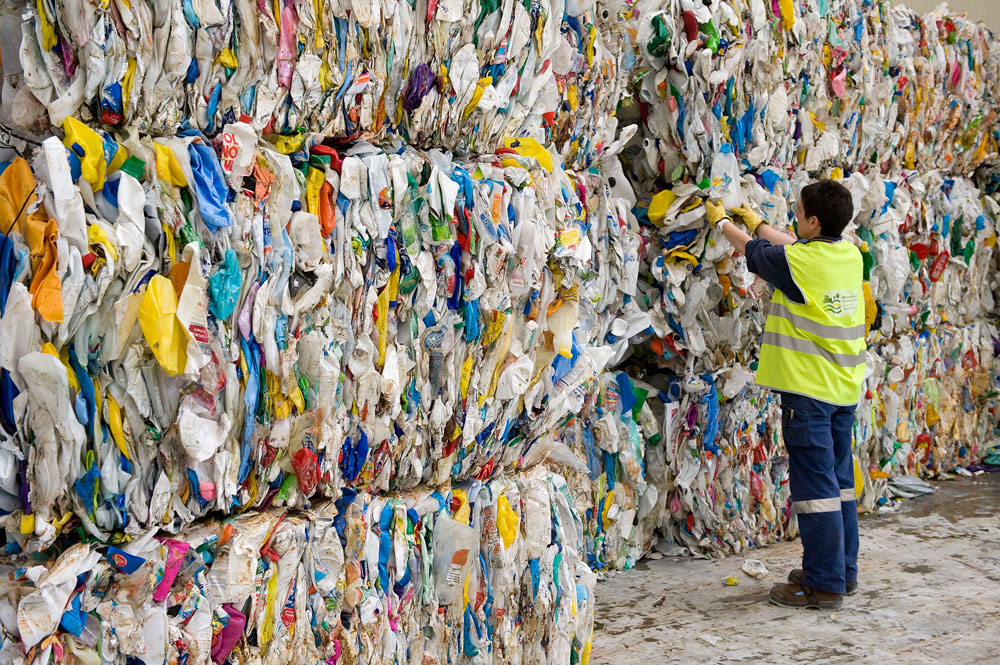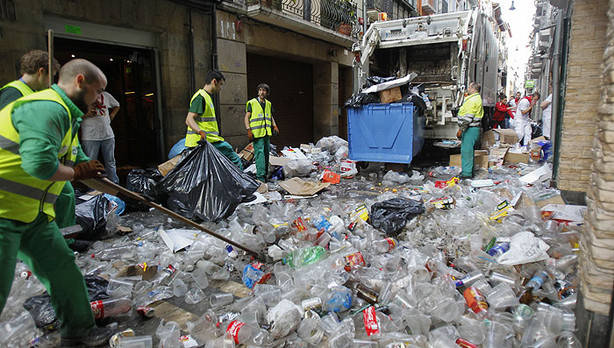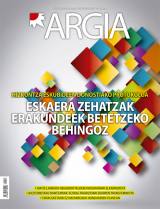Navarre's waste plan brings the revolution
- The possibility of submitting claims to the plan will be closed on 26 October. The Government of Navarra wants to launch a new waste culture for the next decade. Reduce, reuse and recycle waste; nothing will go to landfill without treatment. All this, leaving aside incineration.

“Waste prevention needs a new approach to waste, a new culture that understands waste as resources, that strengthens the active commitment of citizens and the work of the whole society to reduce waste and its consequences. The new culture must also have a different view of the results, with a view to society, the economy and the environment.”
The prevention programme and waste management plan of Navarra is a phrase of the 2017-2027 project that summarises the plan of the Government of Uxue Barkos. It is also a mirror of the great advances in waste management that have been made in the Basque Country in the last decade.
The Foral Community, however, does not come hand in hand with this plan, as Navarre is a pioneer in reuse and recycling. At the beginning of the twentieth century, several pilot experiments were carried out in Ansoáin, in the district of San Juan de Pamplona and, among others, in Ermitagaña… at the time of the first mayor of Pamplona after the Transition, Julián Balduz (PSOE). These accounts can be read in number 156 of LARRUN, counted by Alfonso Del Val.
A participatory process of one and a half years
This plan was launched at the end of the UPN Government in February 2015. The Government of Yolanda Barcina had already drawn up a plan for incineration, but the Superior Court of Justice of Navarra rejected it following complaints from the association Subai Erakuntza and the Sakana Commonwealth. The Court considered that the plan did not take into account where the incinerator was built and that the private interests of the Portland cement company of Olazti were prioritised to the detriment of the public interest.
By 2027 75% of the total waste will be reused or recycled,
recovered, and the remaining 25% will be destined for landfill, provided that it has been treated
The UPN government’s connection to the plan took place for a few months, following the 2015 election, when a change government was formed in Navarre. Subsequently, government agreements with the support of Geroa Bai, EH Bildu, Podemos and Left-Ezkerra established the need to develop a new waste plan. Major changes in municipalities would also be in favour of the new plans.
The plan launched in February was continued, as a participatory process had been opened, but very different criteria were introduced to the assemblies that brought together authorities, institutions, associations and citizens. Basically, the deadline for participation has been extended by one and a half years between February last year and September 2016. This broad period has brought together many debates and views, but also a broad consensus for the end.
Reversing the situation
The need to replace the current linear economy with the circular economy, the fight against climate change and the impetus of EU directives have been the focus of the new plan. The main objective with the Plan is to reverse the waste policy: at present, if the force is mainly put into waste management and disposal, the new Plan will primarily focus on prevention and management.
According to this, 75% of the total waste will be reused or recycled by 2027 and the remaining 25% will be destined for landfill, provided that it has been treated. In other words, nothing is going to go untreated to the landfill. Currently, 32 per cent are valued and 68 per cent are dedicated to disposal.

Collection of domestic and commercial waste is a key element in achieving these objectives. This waste will therefore be collected in five fractions: organic, materials (plastic, metals and brik, whether packaging or not), paper, glass and so on. As a result of the prevention work, 10% less waste will be generated in 2027 than in 2010, 252,000 tonnes, of which 67% will be collected selectively and 33% will be a fraction of the rest.
2017 will be the year of the Foral Waste Act, in 2018 will be submitted to Parliament and will be in force by mid-2018, or by January 2019 at the latest.
Household bio-waste is expected to make the biggest leap, from 10% of the total fraction collected in 2014 to 33% in 2027, going in tons from 25,554 to 81,440 tons per year. To do so, two key measures will be taken: on the one hand, organic will be collected as a fraction throughout Navarre and, on the other hand, organic will be required to be collected as a fraction. Each community will have to decide which collection system to use for this, but always guaranteeing 70% collection.
No to incineration
One of the keys to the Plan is that the use of incineration is totally discarded. In the first steps of the sludge, the incinerator itself was eliminated, but not incineration, as in the case of cement plants. However, as it progressed, this possibility was completely overflowing.
In this sense, it contrasts greatly with Bizkaia and Gipuzkoa, especially with the latter. Gipuzkoa has 700,000 inhabitants and Navarre with 640,000, while the Provincial Council of Gipuzkoa is going to build an incinerator in Zubieta and the Government of Navarre has ruled out it. Many ratings can be made about these options, but the fact that what is not possible in Gipuzkoa is in Navarra says a lot about betting and commitments to change in both.
Treatment: proximity as key
In Navarre, it is the communities that are responsible for the collection of waste. Two major entities are then responsible for transport and treatment: Community of the Region of Pamplona (55% of the population of Navarre) and Waste Consortium of Navarre (14 other communities). The closer the waste treatment infrastructure of the collection, the more efficient and cheaper the management is.
The Plan will focus mainly on existing infrastructures, for which several of these new functions will be ensured. The new infrastructure can be a new collection plant, a new transfer plant in Berriozar, a new reuse plant in Berriozar and four new composting plants for recycling in Sangüesa, Santesteban, Arbizu and Comarca.
Gipuzkoa has 700,000 inhabitants and Navarre with 640,000, the Provincial Council of Gipuzkoa is going to build the incinerator in Zubieta and the Government of Navarra rules out incineration
There's also a debate about composting. The Gipuzkoan authorities question the solution that can be given to the amounts of compost generated in organic. According to the authorities of the Government of Navarra, this issue will not be a problem at least in Navarre: after all, when organic quality is included as a fraction, it is good - at least at B- level and only represents 10-15% of the total organic compost. Everything would be for agricultural use.
Financing and taxation
The implementation and development of the measures and actions provided for in the Waste Plan will amount to EUR 93.8 million. The waste prevention and management budget for the whole decade 2017-2027 would amount to EUR 698 million. Its funding would be 18% private and 82% public, both from the Government of Navarra and from local authorities.

There is another key element in this plan: taxation. The tax framework will be regulated by law, but basically the one who does well will pay less and the one who does evil more. The good thing to do is to classify, reuse and recycle, and the bad to do is to put it into the landfill. In this respect, waste destined for disposal in landfill will be charged a fee, it is planned to be launched from 2019 and the money collected will be used to promote good practice. The Plan does not yet specify how the system will function.
The draft plan is currently in the final steps. On 26 October the deadline for the submission of claims will end, after which it will be definitively drafted for approval by the Government of Navarra. I guess around November. Then, 2017 will be the year of the elaboration of the Foral Waste Law, in 2018 it will be submitted to Parliament and will be in force by mid-2018 or, at the latest, in January 2019.


August is the holiday month for many people, including those who rule. And yet it is common to take advantage of the month of August to deal with some issues without much noise, albeit of great importance.
This is what is happening with the project to centralize sludge... [+]
125 milioi eurorekin, Nafarroako aurrekonturik handienetan hirugarrena du Iruñerriko Mankomunitateak, eta 350.000 biztanle ingururi ur hornidura, zaborren bilketa edo hiri garraioa eskaintzen dizkie. Irailaren 28an ikusmin handia piztu zuen mankomunitateko presidentea... [+]
Berez Navarra Sumako hautagaiak irabaziko zuela aurreikusten zen, baina ostegun goizean Aritz Ayesa EH Bilduko hautagaiak eta orain arteko lehendakariak bere hautagaitza erretiratu zuen, adieraziz saiatuko zirela independenteren bat atera zedin lehendakari.






















